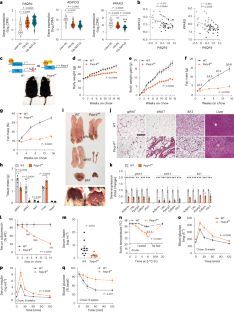PAQR4 regulates adipocyte function and systemic metabolic health by mediating ceramide levels
IF 18.9
1区 医学
Q1 ENDOCRINOLOGY & METABOLISM
引用次数: 0
Abstract
PAQR4 is an orphan receptor in the PAQR family with an unknown function in metabolism. Here, we identify a critical role of PAQR4 in maintaining adipose tissue function and whole-body metabolic health. We demonstrate that expression of Paqr4 specifically in adipocytes, in an inducible and reversible fashion, leads to partial lipodystrophy, hyperglycaemia and hyperinsulinaemia, which is ameliorated by wild-type adipose tissue transplants or leptin treatment. By contrast, deletion of Paqr4 in adipocytes improves healthy adipose remodelling and glucose homoeostasis in diet-induced obesity. Mechanistically, PAQR4 regulates ceramide levels by mediating the stability of ceramide synthases (CERS2 and CERS5) and, thus, their activities. Overactivation of the PQAR4–CERS axis causes ceramide accumulation and impairs adipose tissue function through suppressing adipogenesis and triggering adipocyte de-differentiation. Blocking de novo ceramide biosynthesis rescues PAQR4-induced metabolic defects. Collectively, our findings suggest a critical function of PAQR4 in regulating cellular ceramide homoeostasis and targeting PAQR4 offers an approach for the treatment of metabolic disorders. PAQR4 regulates cellular ceramide synthesis and accumulation to mediate adipose tissue function, glucose homoeostasis and, thus, systemic metabolic health.


PAQR4 通过介导神经酰胺水平调节脂肪细胞功能和全身代谢健康
PAQR4 是 PAQR 家族中的一个孤儿受体,在新陈代谢中的功能尚不清楚。在这里,我们发现了 PAQR4 在维持脂肪组织功能和全身代谢健康方面的关键作用。我们证明,以诱导和可逆的方式在脂肪细胞中特异性表达 Paqr4 会导致部分脂肪营养不良、高血糖和高胰岛素血症,而野生型脂肪组织移植或瘦素治疗可改善这些症状。相比之下,在饮食诱导的肥胖症中,脂肪细胞中的 Paqr4 基因缺失可改善健康脂肪重塑和血糖平衡。从机理上讲,PAQR4 通过调节神经酰胺合成酶(CERS2 和 CERS5)的稳定性进而调节其活性,从而调节神经酰胺水平。PQAR4-CERS 轴的过度激活会导致神经酰胺积累,并通过抑制脂肪生成和引发脂肪细胞去分化来损害脂肪组织的功能。阻断从头开始的神经酰胺生物合成可挽救 PAQR4 诱导的代谢缺陷。总之,我们的研究结果表明 PAQR4 在调节细胞神经酰胺平衡中起着关键作用,而靶向 PAQR4 则为治疗代谢紊乱提供了一种方法。
本文章由计算机程序翻译,如有差异,请以英文原文为准。
求助全文
约1分钟内获得全文
求助全文
来源期刊

Nature metabolism
ENDOCRINOLOGY & METABOLISM-
CiteScore
27.50
自引率
2.40%
发文量
170
期刊介绍:
Nature Metabolism is a peer-reviewed scientific journal that covers a broad range of topics in metabolism research. It aims to advance the understanding of metabolic and homeostatic processes at a cellular and physiological level. The journal publishes research from various fields, including fundamental cell biology, basic biomedical and translational research, and integrative physiology. It focuses on how cellular metabolism affects cellular function, the physiology and homeostasis of organs and tissues, and the regulation of organismal energy homeostasis. It also investigates the molecular pathophysiology of metabolic diseases such as diabetes and obesity, as well as their treatment. Nature Metabolism follows the standards of other Nature-branded journals, with a dedicated team of professional editors, rigorous peer-review process, high standards of copy-editing and production, swift publication, and editorial independence. The journal has a high impact factor, has a certain influence in the international area, and is deeply concerned and cited by the majority of scholars.
 求助内容:
求助内容: 应助结果提醒方式:
应助结果提醒方式:


